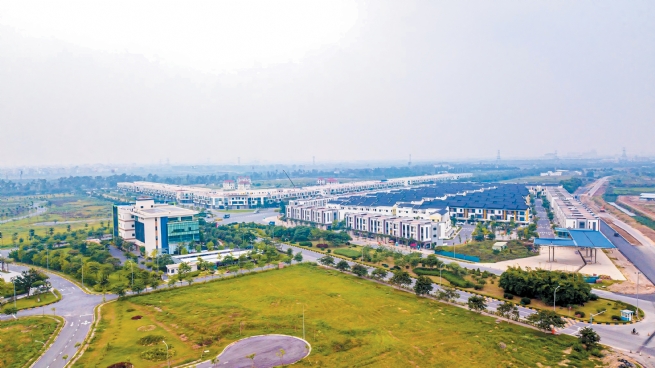10:11:04 AM | 8/8/2024
Vietnam's industrial property market is showing signs of recovery and positive development following a challenging year in 2023. Industry experts and insiders are optimistic about the market's future, particularly in light of the rebounding economy and growing export activities.

A view of VSIP Bac Ninh
Speaking at the recent Vietnam Industrial Property Forum 2024, Mr. Le Trong Minh, Editor-in-Chief of Dau Tu (Investment) Newspaper, said that the scale and trends of global investment capital flows currently continue to change dramatically due to external geopolitical factors as well as economic volatility of major countries. While the global supply chain is being reshuffled and the world economy is witnessing rapid, complicated and unpredictable developments, Vietnam is still considered a bright spot on the FDI map in the medium and long term.
Development potential
“We are seeing a strong shift in the industrial sector, especially increased investment in industrial parks and factories. Vietnam is not only an attractive destination for international investors but it is also building a solid foundation for sustainable development,” he emphasized.
He highlighted the factors that make Vietnam a bright destination, citing “a stable macro economy, good inflation control, positive and impressive economic growth in a difficult context.” In 2023, Vietnam achieved a GDP growth rate of 5.05%, with import and export values exceeding US$354 billion, a trade surplus of over US$28.3 billion, a GDP size of US$430 billion, and a per capita income surpassing US$4,320. In the first half of 2024, the Vietnamese economy continued to show strong performance, with GDP growth estimated at 6.42%. This exceeds the projected growth scenario and provides momentum towards meeting the annual economic growth target of 6.5% to 7%.
In addition, the business environment in Vietnam continued to improve. In 2023, registered FDI capital exceeded US$39.4 billion, up 34.5% year on year, and disbursed FDI capital reached a record US$23.2 billion. In the past seven months, newly registered FDI capital was over US$18 billion, representing a year-on-year growth of 10.9%, demonstrating strong confidence of foreign investors in Vietnam's investment environment. Major semiconductor, energy, component manufacturing, electronics and high value-added projects tended to increase. Specially, Vietnam recently caught the fancy of the semiconductor supply chain. Many giant semiconductor and AI firms such as Amkor, NVIDIA and Hana Micron expressed their interest in new investments and expansion investments in Vietnam.
At the same time, Vietnam's international standing is rising, with its integration into the global economy deepening through the signing and implementation of 16 free trade agreements (FTAs) and the ongoing negotiation of three additional FTAs. The country is now ranked among the Top 20 trade partners globally, demonstrating an openness rate exceeding 200%. Investors from 144 countries and territories have invested over US$484 billion to more than 40,544 projects in Vietnam.
Vietnam has advantages in human resources and a domestic market with nearly 100 million people. Infrastructure projects have been increasingly synchronized and completed to reduce transportation, logistics and input costs for companies and enhance economic competitiveness.
Challenges
Although Vietnam is highly appreciated for its investment potential, the industrial real estate market still faces a lot of challenges that need to be addressed. Tom Over, Director of Transportation and Industry, JLL Vietnam and Asia-Pacific, noted that some investors have opted for Thailand and Malaysia due to their clearer investment incentives, streamlined licensing processes, and well-established labor resources. In contrast, Vietnam is experiencing a shift from warehouses to manufacturing facilities, which presents both new opportunities and significant challenges.
One major challenge is the absence of an action roadmap and legal framework to support the development of eco-industrial parks. Currently, Vietnam does not have specific and comprehensive regulations on converting existing industrial parks into eco-industrial parks. This situation has led to a complex regulatory landscape for green and smart industrial parks, as various laws and regulations outline differing requirements. This complexity can result in confusion and difficulties in implementation. Standards for waste recycling and reuse are not clearly defined, and there are overlaps and confusions in industrial waste management.
Another matter is the lack of licenses for businesses to reuse or trade treated wastewater, along with the lack of tax support policies for eco-certified businesses. This has led to a shortage of financial incentives for developers to implement environmental protection initiatives.
To overcome these barriers, it is necessary to complete legal documents on the reuse of raw materials and waste and foster the circular economy in industrial parks. It is important to closely coordinate international organizations, business associations, climate finance funds and commercial banks to mobilize resources. In addition, adding financial incentives is critical to encourage businesses to convert and build eco-industrial parks.
The Ministry of Planning and Investment is currently finalizing the draft Law on Industrial Zones and Economic Zones to facilitate the development of new industrial park models. The ministry is committed to coordinating with localities to ensure that industrial zones and economic zones will develop rapidly, sustainably and effectively.
For localities and industrial park infrastructure developers, it is necessary to focus on breakthrough solutions. This includes pioneering changes in industrial park development models, such as eco-industrial parks, supporting industrial parks, and high-tech parks. At the same time, it is very important to take science, technology and innovation as the pillars of future development. It is crucial to actively create a favorable environment for tech firms and startups and allocate land and resources for research and development (R&D) projects to apply new technologies and test products.
By Giang Tu, Vietnam Business Forum